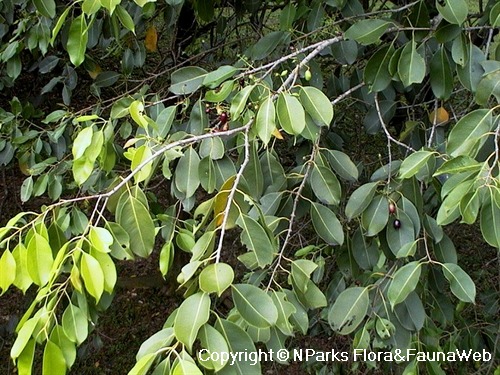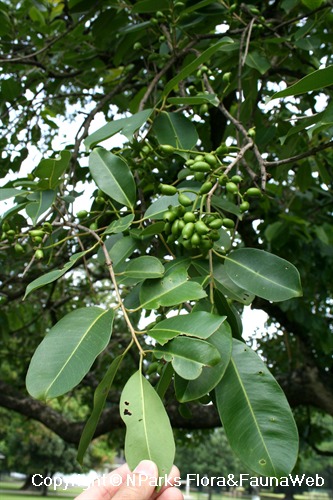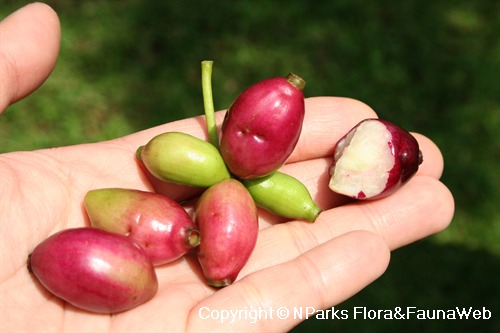
Back
Syzygium cumini (L.) Skeels
| Family Name: | Myrtaceae |
| Synonyms: | Myrtus cumini, Calyptranthes jambolana, Syzygium jambolanum, Eugenia jambolana, Eugenia cumini |
| Common Name: | Java Plum, Jambolan, Jiwat, Salam, Kerian Duat, 乌墨, 乌口树, 乌木, 黑墨树, 海南蒲桃 |
Name
Classifications and Characteristics
| Plant Division | Angiosperms (Flowering Seed Plants) (Dicotyledon) |
|---|---|
| Plant Growth Form | Tree (Medium (16m-30m)) |
| Lifespan (in Singapore) | Perennial |
| Mode of Nutrition | Autotrophic |
| Maximum Height | 12 m to 30 m |
| Tree or Palm – Trunk Diameter | 0 to 0 |
Biogeography
| Native Distribution | Tropical eastern Africa, China, India, Malaysia, Indonesia |
|---|---|
| Native Habitat | Terrestrial (Secondary Rainforest, Monsoon Forest, Temperate Forest, Riverine) |
| Preferred Climate Zone | Tropical, Sub-Tropical / Monsoonal, Temperate |
| Local Conservation Status | Non-native (Spontaneous (Naturalised)) |
Description and Ethnobotany
| Others - Plant Morphology | Fairly fast-growing tree with dense crown, reaches full size in 40 years. Typically forks into multiple trunks at around 0.9-1.5m near the ground. Mature leaves glossy dark green with yellow mid-rib, young leaves pinkish, scented like turpentine. Flowers small, produced in powderpuff inflorescences, fragrant. aging from creamy-white to rose-pink before dropping off. Fruit formation occurs around 32 days after flowering. Fruits are fleshy, obong berries (2 x 1.7cm), ripening from green to purplish-red to shiny purplish-black. Attractive to birds, squirrels, monkeys and feral pigs. Edible raw, taste ranges from astringent sour to fairly sweet.Plant blooms from May to August in Malaysia, and fruits can be harvested in Nov to Dec. Seeds are recalcitrant and do not not dry or store well -- to be sown soon after collection. May be planted lose together as wind-break. Tolerates drought and short-term flooding when established. |
|---|---|
| Ethnobotanical Uses | Edible Plant Parts : Edible Fruits Food (Fruit or Vegetable) (Herb or Spice) Others: Flowers are a good source of nectar and used to make good quality honey. Fruits eaten raw or made into juice, sauces, jams and preserves. Fermented fruits made into wine or vinegar. High in vitamins A and C. Many parts of plant used as remedies in traditional medicine. Leaves and bark used against diarrhoea, dysentery, digestive ailments and fever. Leaves, bark, flowers, fruits and seeds reported to be effective in treating diabetes. Leaves and bark used to reduce blood pressure and treat bleeding gums. Bark yields brown dye and tannin used in tanning leather and preserve fishing nets. Wood is strong and water-resistant, used to make railway sleepers and funiture. Plant regarded as sacred to Buddhists and Hindus, and commonly planted in temple compounds. Leaves and fruits used in religious worship. Many Hindus called the plant the "fruit of the gods" because Lord Rama is said to have subsisted on the fruit in the forest for 15 years during his exile from Ayodhya. |
Landscaping Features
| Desirable Plant Features | Fragrant (Flowers) (Day) |
|---|---|
| Landscape Uses | General, Suitable for Roadsides, Shade Providing Tree / Palm |
| Thematic Landscaping | Economic Garden, Naturalistic Garden |
Fauna, Pollination and Dispersal
| Fauna Pollination Dispersal Associated Fauna | Bird-Attracting, Butterfly-Attracting |
|---|---|
| Pollination Method(s) | Biotic (Fauna) (Insects (Bee)) |
| Seed or Spore Dispersal | Biotic (Fauna) |
Plant Care and Propagation
| Light Preference | Full Sun |
|---|---|
| Water Preference | Moderate Water |
| Plant Growth Rate | Moderate |
| Rootzone Tolerance | Drought Tolerant, Waterlogged Soils (Drains Site), Fertile Loamy Soils, Well-Drained Soils |
| Maintenance Requirements | Moderate |
| Propagation Method | Seed, Stem Cutting |
| Propagation Method Remarks | Seeds do not dry or store well. Sow as soon as possible after collection. |
Foliar
| Foliage Retention | Evergreen |
|---|---|
| Mature Foliage Colour(s) | Green |
| Mature Foliage Texture(s) | Smooth, Glossy / Shiny, Thick |
| Prominent Young Flush Colour(s) | Pink |
| Foliar Type | Simple / Unifoliate |
| Foliar Arrangement Along Stem | Opposite |
| Foliar Shape(s) | Non-Palm Foliage (Oblong) |
| Foliar Venation | Pinnate / Net |
| Foliar Margin | Entire |
| Foliar Apex - Tip | Acuminate |
| Foliar Base | Rounded / Obtuse |
| Typical Foliar Area | Mesophyll ( 45cm2 - 182.25 cm2 ) |
| Leaf Area Index (LAI) for Green Plot Ratio | 3.0 (Tree - Intermediate Canopy) |
Non - Foliar and Storage
| Trunk Type (Non Palm) | Woody |
|---|---|
| Bark Colour(s) | Grey |
| Mature Bark Texture | Scaly |
| Stem Type & Modification | Woody |
| Root Type | Underground (Tap Root, Fibrous Root) |
Floral (Angiosperm)
| Flower & Plant Sexuality | Bisexual Flowers |
| Flower Colour(s) | Cream / Off-White, Pink |
|---|---|
| Inflorescence Type | Panicle |
| Flowering Period | Once Yearly |
| Flowering Habit | Polycarpic |
| Inflorescence Size Remarks | Flowers age from creamy-white to rosy pink. |
Fruit, Seed and Spore
| Mature Fruit Colour(s) | Black, Blue |
|---|---|
| Fruit Classification | Simple Fruit |
| Fruit Type | Fleshy Fruit , Berry |
Image Repository
Others
| Master ID | 1865 |
|---|---|
| Species ID | 3158 |
| Flora Disclaimer | The information in this website has been compiled from reliable sources, such as reference works on medicinal plants. It is not a substitute for medical advice or treatment and NParks does not purport to provide any medical advice. Readers should always consult his/her physician before using or consuming a plant for medicinal purposes. |








.jpg)
.jpg)



